Studio Visit
How Dustin Yellin, Master of Universes, Oversees a Primordial Soup of Creativity at His Red Hook, Brooklyn, Hub
Recent paintings by the artist are currently on view at Venus Over Manhattan in New York.

Recent paintings by the artist are currently on view at Venus Over Manhattan in New York.

Katie White

Dustin Yellin is about as synonymous with his studio’s neighborhood as an artist can get. Almost 20 years ago, the California-born, Colorado-raised artist set up a studio in Red Hook, Brooklyn, a then down-on-its-luck neighborhood set against the city’s historic shipping yards and industrial warehouses. There he’s stayed, moving between local three studios. He further solidified his commitment to the neighborhood when, in 2012, he founded Pioneer Works, a nonprofit art space to bring artists, scientists, inventors, musicians, and many others together in one space. It has since become a leading force in the Red Hook community.
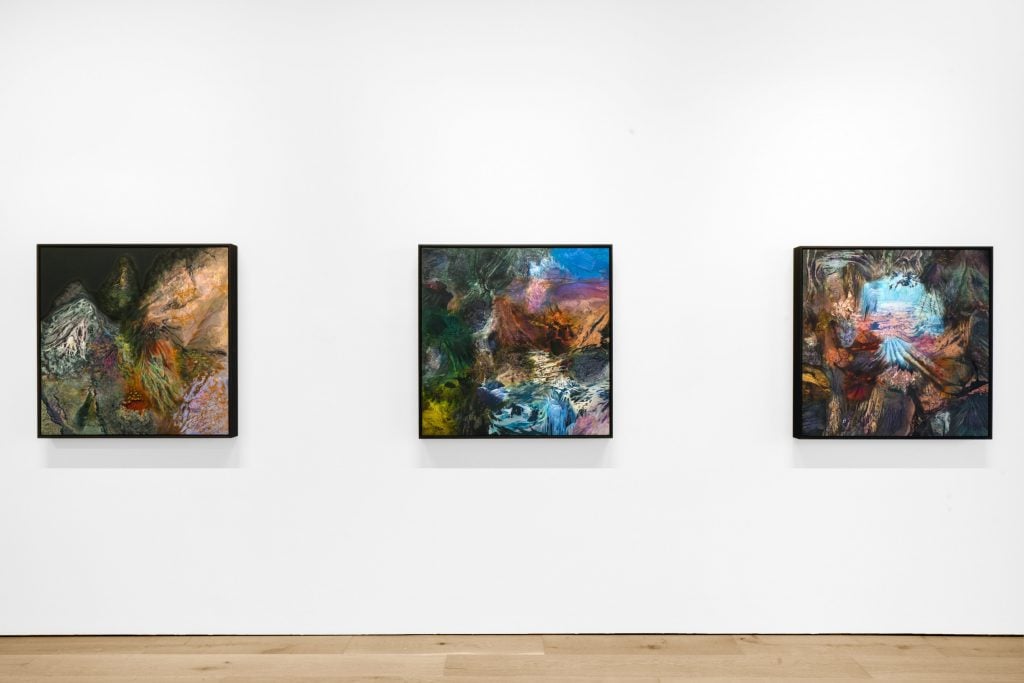
Installation view of “Dustin Yellin: Cave Painting at Venus Over Manhattan,” New York, 2023.
Over these years, Yellin’s artistic star rose, too, on the strength of his life-size sculptures containing layers of multimedia collage and paint, offering up fantastical visions trapped in glass or acrylic. These eye-dazzling works shift from two-dimensional to three-dimensional, depending on the viewer’s position. In his most famous series, “Psychogeopraphies,” these collages take the shape of human figures, seemingly exploding with lush imagery often drawn from the natural world.
Though he is best known for sculpture, Yellin is also a devoted painter. Right now, New York’s Venus Over Manhattan is presenting “Dustin Yellin: Cave Painting,” an exhibition of recently completed canvases exploring the imagery and themes of caves. These paintings consider caves as both as fascinating natural phenomena as well as metaphorical spaces and chambers for the safekeeping or hiding of stories, artifacts, and secrets. The proceeds from one painting, Zia Copernicus Falls No. 4 (2023) is being donated to the artist-founded initiative, Art into Acres, in conjunction with conservation organizations Tuleyome and Re:wild.
Recently we caught up with Yellin at his Red Hook studio, where the energy is constantly buzzing with music and power tools.
Tell us about your studio. Where is it, how did you find it, what kind of space is it?
I’ve been in Red Hook for about 17 years. I started off in a small studio in the area before I moved into a larger one, which then got taken out by Hurricane Sandy. I was just beginning to renovate Pioneer Works at the time, and the building next door became available, so I moved in. It was a rundown warehouse at the time but had good bones for a studio: tall ceilings, lots of natural light, plenty of space to think, paint, sand, cut, draw, concoct, etc.

Courtesy of Dustin Yellin Studio.
Do you have studio assistants or other team members working with you? What do they do?
I have many talented people helping me make work every day. From painters and fabricators to my office team, everyone plays a crucial role in this ecosystem. The painters are doing everything from cutting things out of National Geographic magazines to detailing flowers, mushrooms, artifacts, roots, tunnels, arches, caves, boulders, suns, moons, fish, etc. My shop team helps sand the work, move the (very heavy) sculptures, and myriad other things. My office team keeps everything organized—they manage my evolving archive, keep track of where the works are at any given time, and work closely with museums, galleries, and potential project collaborators. The list goes on.
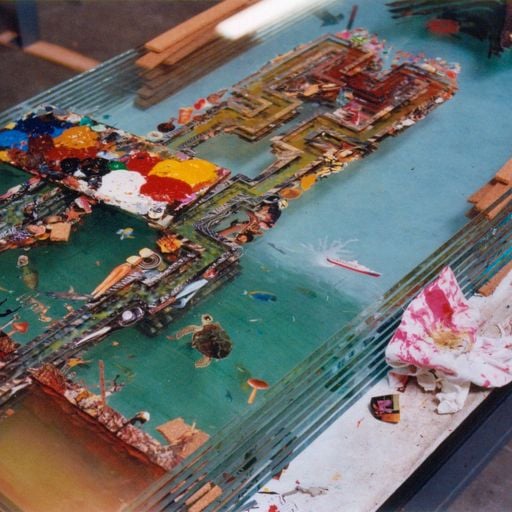
Courtesy of Dustin Yellin Studio.
What are you working on right now? Please send us a few smartphone shots of a work in progress—or photos of different works in various states of completion—in a way that you think will provide insight into your process.
I’m working on collages, sculptures, animations, and many other strange investigations. I’m slowly finishing up the “Psychogeographies.” I spent the last year working on paintings for my exhibition “Cave Painting” at Venus Over Manhattan. I am also working on a cast stainless-steel sculpture made out of 75 disparate parts, titled Emergence. It is a humanoid figure that is coming from a primordial prebiotic soup from which all life on Earth developed. The form emerges from the 1919 solar eclipse that [astronomer Arthur] Eddington observed to help prove the theory of general relativity. Two-dimensional figures are coming out of the eclipse and then morph into three-dimensional figures.
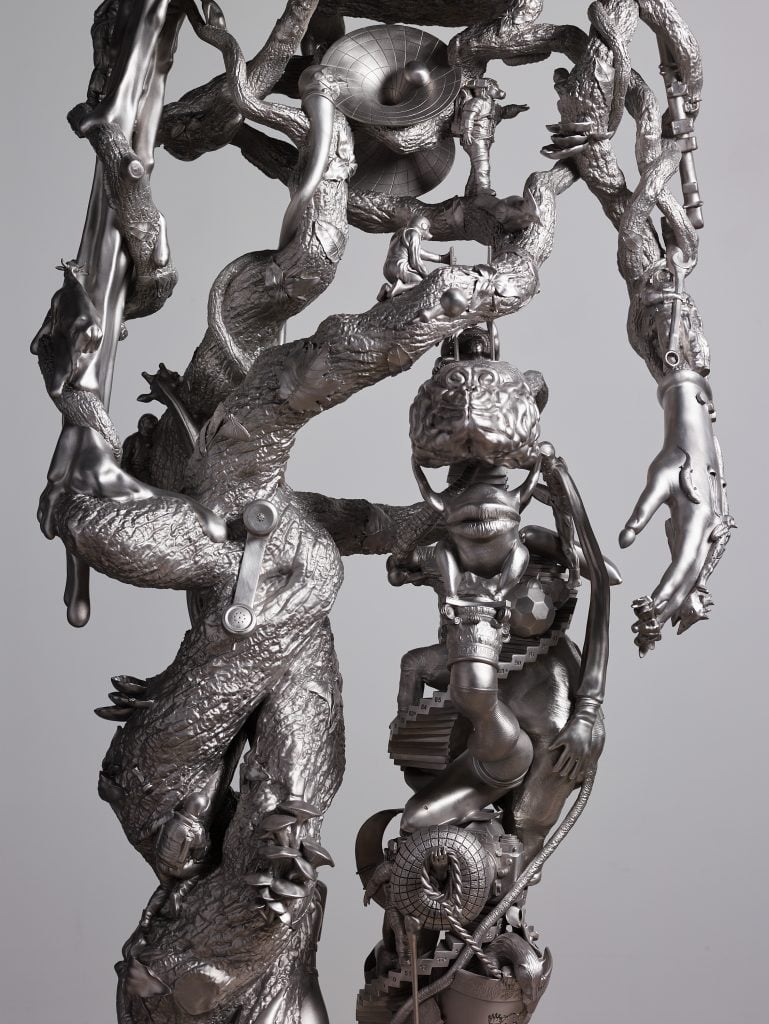
Courtesy of Dustin Yellin Studio.
There is a cat with the ass of a dog staring into a toilet to see its reflection like Narcissus. There’s a goat staring into the eyes of the cat as an allusion to Renaissance paintings. The toilet is sitting on a Rubik’s Cube made out of a Periodic Table of elements. Above that is a battery-operated frog licking a bagel that is a Black Hole. Then you have a monkey man coming out of a monkey brain. A council of pigeons convenes under the volcano. On the top of the volcano is a moon with a reference to Sisyphus. The longer you look at it, the more you’ll find. It will go to the Well in Toronto next fall as a public installation.
I’m also working on an animation with a crocodile astronaut in blue jeans who visits a pastel pink desert dream world and then breakdances on a patch of sky in the sea. He flies into the mouth of a whale before a laser hits the sun, causing it to explode and fall into the ocean. The whale eats pieces of the sun. I’m still working on it.
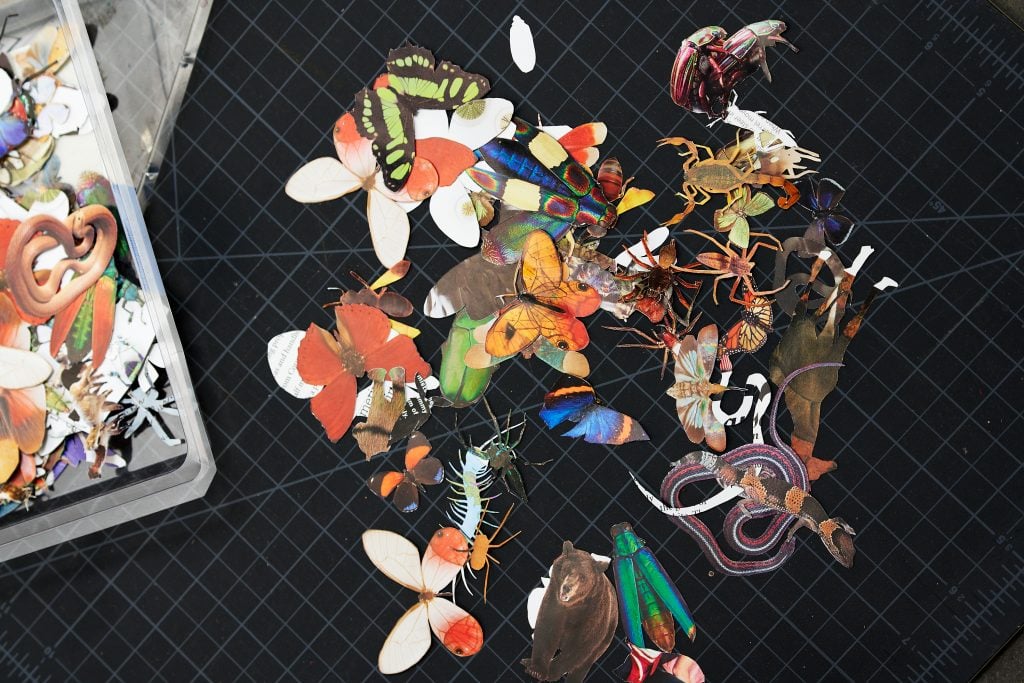
Courtesy of Dustin Yellin Studio.
What tool or art supply do you enjoy working with the most, and why? Please send us a snap of it.
In the seed of the heart, collage is where my juice doth lie. And when I say collage, I don’t just mean paper. I make them using paper, yes, but also paint, metal, rocks, wood….Anything can be a collage, and the materials used are interconnected membranes of matter that propel the mitochondria of our universe.
What kind of atmosphere do you prefer when you work?
I like environments that hum with productivity and collaboration. Places where you can feel the construction of something new floating through the air all the time. This energy can take on many forms, and different workflows come together in different ways in my practice. In Brooklyn, the studio is very collaborative, but my studio upstate is solitary.
My Brooklyn space buzzes with bodies and sounds. There are usually a minimum of ten people working here on a given day—often more—and a constant stream of visitors, friends, students, and Pioneer Works staff coming in and out. In the warmer months, the studio gate is open, and anyone can walk in off the street.
My studio at my home upstate is a little different. I can sit in stillness, overlooking a lake, and listen to the orchestra of birds, insects, and trees.
I like both modes of stimulation.
When you feel stuck while preparing for a show, what do you do to get unstuck?
I try to go as far away as possible, throwing myself into the most unpredictable and remote environments. Last month, a week before the opening of my exhibition, I trekked into the world’s largest known cave in Vietnam, so vast it has its own ecosystem. I have a need to observe the chaotic, natural processes of our Earth.
Or I read a poem.
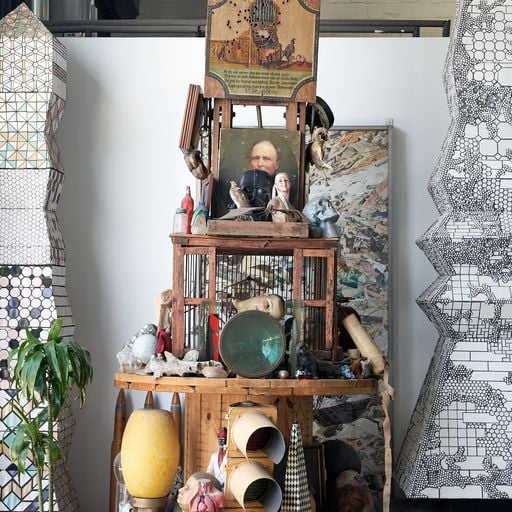
Courtesy of Dustin Yellin Studio.
What images or objects do you look at while you work? Do you have any other artists’ work in your studio? If so, please share a phone pic and tell the story behind it.
I love objects and artifacts, and my studio is full of them. I’m surrounded by books, animal bones, rocks, an old jukebox, and antique mannequin heads. A portion of my collection lives on an altar by the entrance of the studio: massive shells, glass apothecary jars, cracked paintings, a Darth Vader mask, dried-up honeycomb, plastic medical models, an old traffic light, a mummified cat…all sit on a 12-foot wooden structure with a chicken coop at its core that once belonged to Genesis P-Orridge.
My studio is also filled with artwork from friends. My studio manager, Colin Oulighan, is a badass artist, and I look at his piece every day in the office.
What’s the last museum exhibition or gallery show you saw that really affected you and why?
The Wangechi Mutu exhibition at the New Museum blew my mind. It made me want to work harder and explore new ways of being and seeing.
Is there anything in your studio that a visitor might find surprising?
There are countless things that one might find surprising in my studio, and this would probably vary drastically from one person’s opinion to the next. One person might simply be surprised by the studio’s dynamic, the sheer number of people working, the energy and constant music and murmur of power tools, the vastness of the space. To someone else, the most surprising thing might be the sperm whale jawbone suspended from the rafters, or the 450 million-year-old rock in the entryway.
Describe the space in three adjectives.
Crazy fucking bananas.